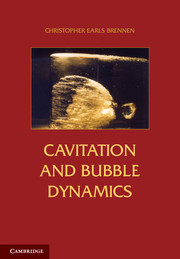7 - Cavitating Flows
Published online by Cambridge University Press: 05 October 2013
Summary
Introduction
We begin this discussion of cavitation in flows by describing the effect of the flow on a single cavitation “event.” This is the term used in referring to the processes that occur when a single cavitation nucleus is convected into a region of low pressure within the flow, grows explosively to macroscopic size, and collapses when it is convected back into a region of higher pressure. Pioneering observations of individual cavitation events were made by Knapp and his associates at the California Institute of Technology in the 1940s (see, for example, Knapp and Hollander 1948) using high-speed movie cameras capable of 20,000 frames per second. Shortly thereafter Plesset (1948), Parkin (1952), and others began to model these observations of the growth and collapse of traveling cavitation bubbles using modifications of Rayleigh's original equation of motion for a spherical bubble. Many analyses and experiments on traveling bubble cavitation followed, and a brief description these is included in the next section. All of the models are based on two assumptions: that the bubbles remain spherical and that events do not interact with one another.
Information
- Type
- Chapter
- Information
- Cavitation and Bubble Dynamics , pp. 182 - 205Publisher: Cambridge University PressPrint publication year: 2013
References
Accessibility standard: Unknown
Why this information is here
This section outlines the accessibility features of this content - including support for screen readers, full keyboard navigation and high-contrast display options. This may not be relevant for you.Accessibility Information
- 1
- Cited by
